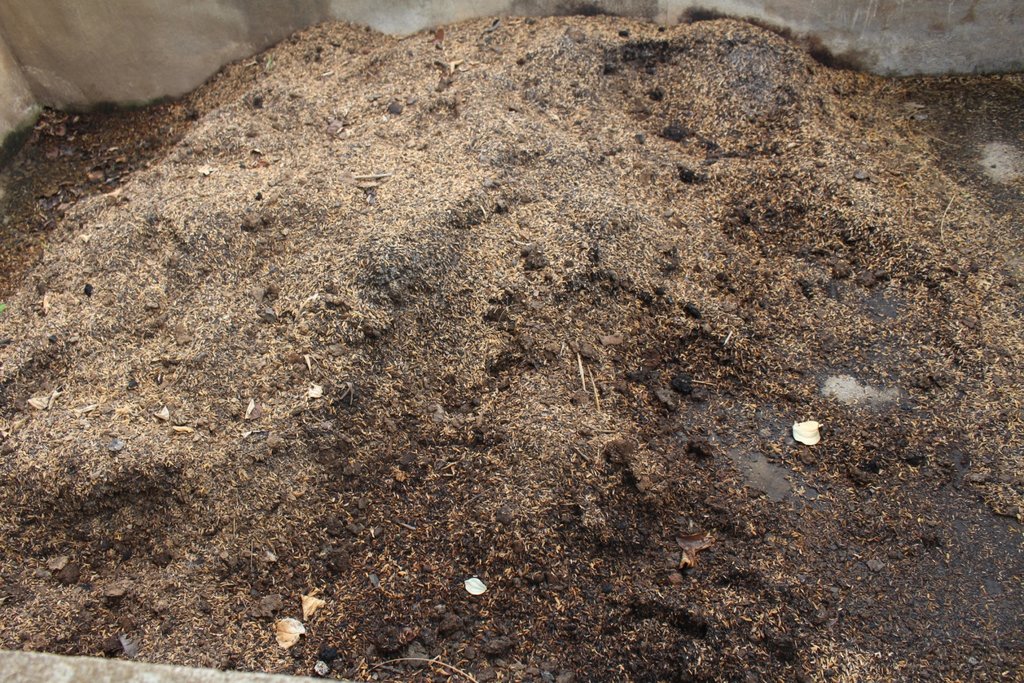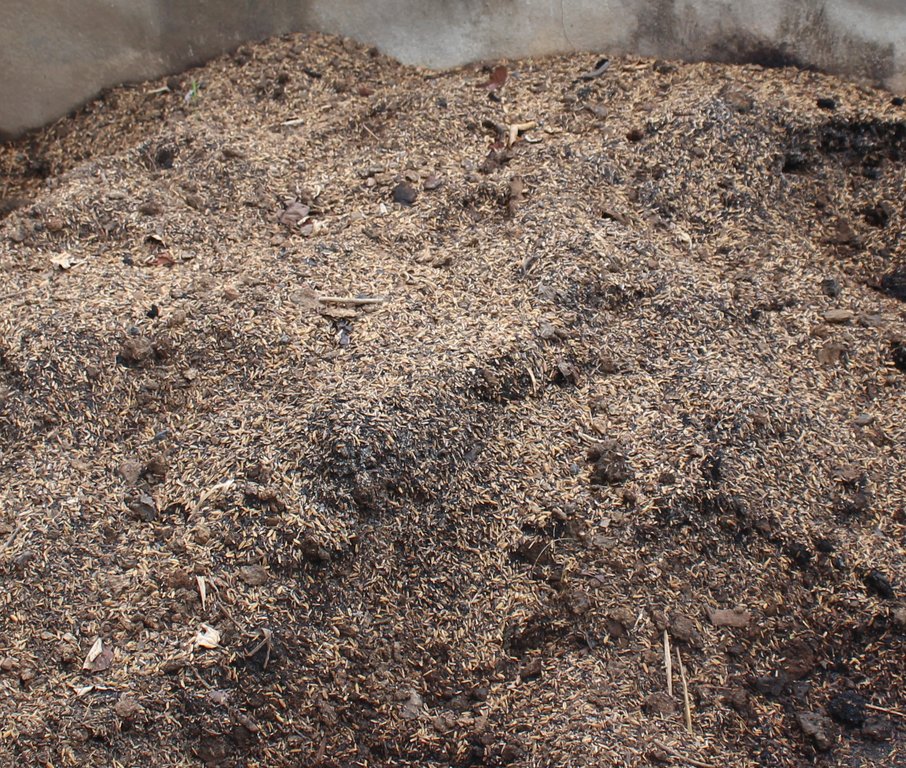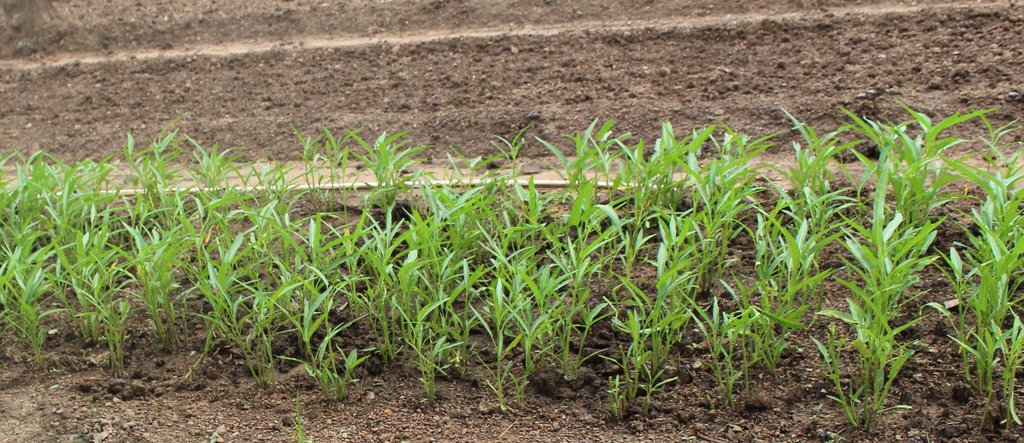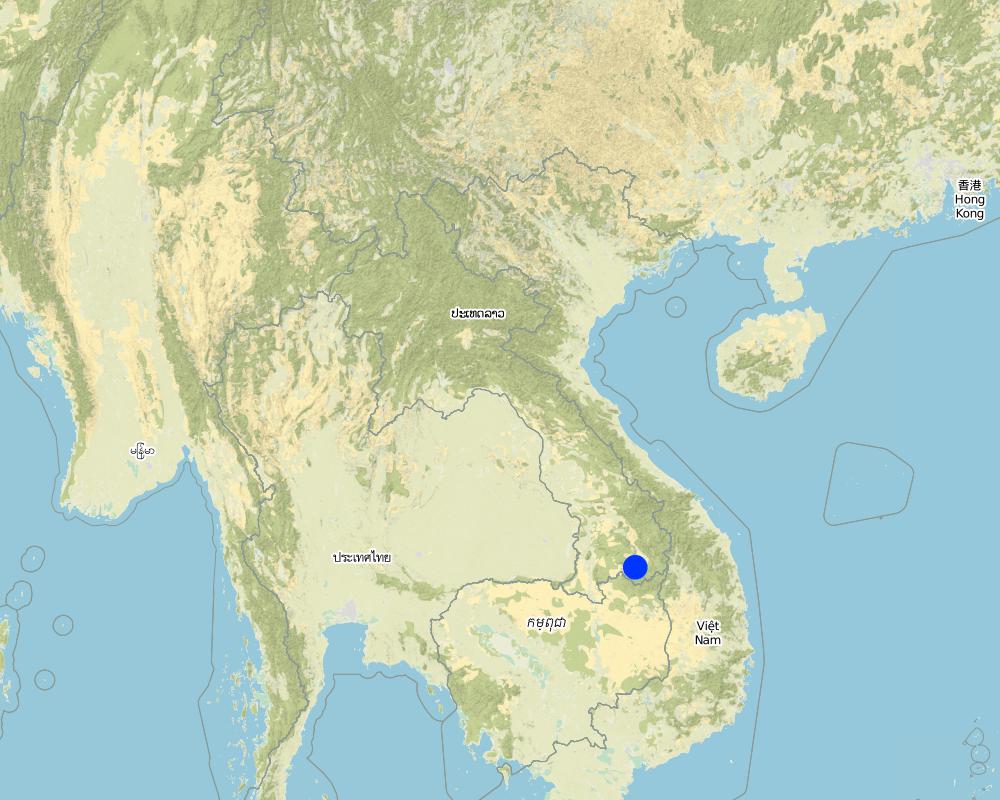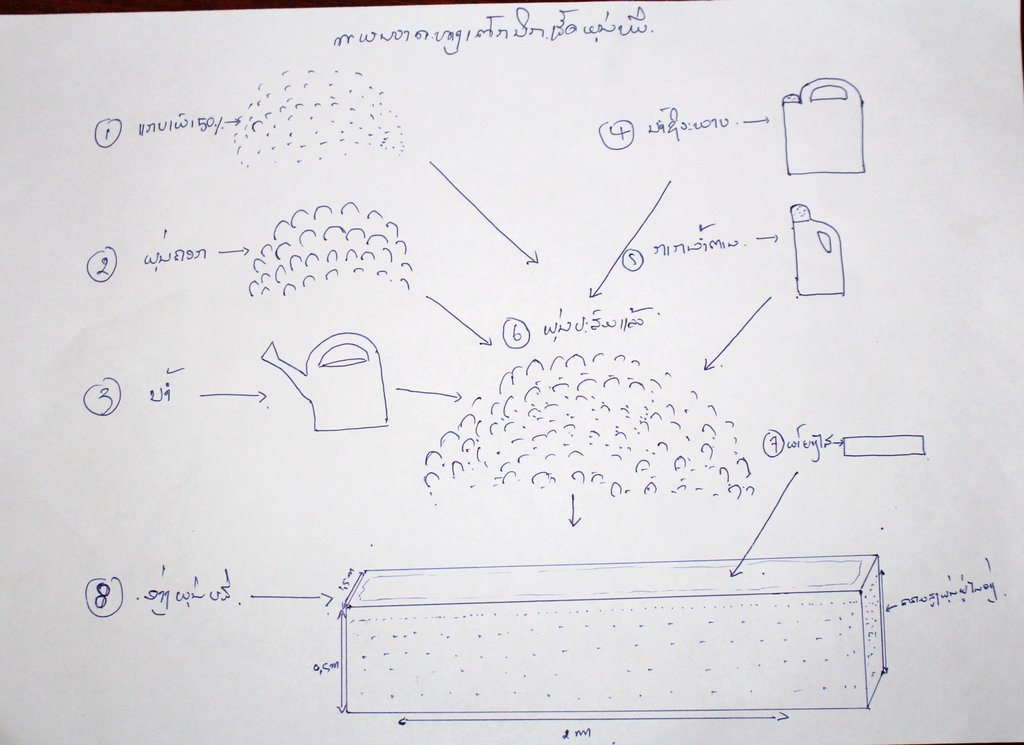Making compost to improve soil fertility in vegetable home gardens [Lao People's Democratic Republic]
- Creation:
- Update:
- Compiler: Visay Visay
- Editors: anousit namsena, Pasalath Khounsy, Bounthanom Bouahom
- Reviewers: Nicole Harari, Nivong Sipaseuth, Alexandra Gavilano
Compost
technologies_2284 - Lao People's Democratic Republic
View sections
Expand all Collapse all1. General information
1.2 Contact details of resource persons and institutions involved in the assessment and documentation of the Technology
Key resource person(s)
SLM specialist:
Thongvongsay Sithvongsay
District of Agriculture and Forestry Office
Lao People's Democratic Republic
land user:
Khounlavong Khou
Lao People's Democratic Republic
Name of project which facilitated the documentation/ evaluation of the Technology (if relevant)
Scaling-up SLM practices by smallholder farmers (IFAD)Name of the institution(s) which facilitated the documentation/ evaluation of the Technology (if relevant)
National Agriculture and Forestry Research Institute (NAFRI) - Lao People's Democratic Republic1.3 Conditions regarding the use of data documented through WOCAT
The compiler and key resource person(s) accept the conditions regarding the use of data documented through WOCAT:
Yes
1.4 Declaration on sustainability of the described Technology
Is the Technology described here problematic with regard to land degradation, so that it cannot be declared a sustainable land management technology?
No
2. Description of the SLM Technology
2.1 Short description of the Technology
Definition of the Technology:
Making compost by burned rice bran to improve the soil fertility in vegetable home gardens.
2.2 Detailed description of the Technology
Description:
Compost is used to improve soil fertility and increase crop production. Vegetable home gardens are generally implemented across the country as part of livelihood activity for food security and other source of household’s income for local people. In the past, local land users only used animal manure for improving crop yield and soil fertility. The amount of animal manure applied was dependent on the potential of each household to collect animal manure. In addition, most agricultural land is sandy with shallow depth and mixed with gravel which is not productive for agriculture. Most of vegetable home gardens are situated along streams or riverbanks near the village whereas arable land availability is an issue. In 2016, the Food Security and Nutrition Market Linkage Project supported by International Fund for Agriculture Development (IFAD) has encouraged local people and provided training on how to prepare and use compost with a view to soil improvement and increased crop yields that subsequently should increase food security. Compost is a simple process where local people can use available materials from their own farm production. Materials for compost production include 10 bags of partly burned rice bran (bran burned up to 50% / 15kg/bag), 200kg of animal manure, 50 litre of water, 15 table spoons of molasses or sugar, 5 table spoons of organic extract. All those materials has to mixed together, then should be putted it in a container which is made of cement or plastic (depth: 0,5 m /width: 1,5 m /length: 2 m). After, the compost material in the concrete tank should be flattened and then covered by a plastic sheet. The decomposing process usually takes between 1-2 weeks before the compost can be applied. Buckets or bags are used to carry the compost from the container to the home gardens where - during the land preparation - it is directly spread out on the vegetable plots by fork. Then, the compost will be mixed with the soil by hoe. Now, the soil is ready for planting. Vegetable cultivation may commence from the end of December to March (2-3 cultivation cycles per year). Most people use water from boreholes for the irrigation of the vegetables. In summary, the advantages of using compost are the improvement of soil fertility by adding more organic matters to the soil, increasing of soil nutrients and activation of the organic decomposition process. These positive effects on soil promote crop growth, and finally ends in increased crop yields. The compost production is not complicated, but it needs to be emphasized that attention should be paid to the cleaning of the storage tank and a careful maintenance of tools including shovels and watering cans to keep the costs as low as possible.
2.3 Photos of the Technology
2.5 Country/ region/ locations where the Technology has been applied and which are covered by this assessment
Country:
Lao People's Democratic Republic
Region/ State/ Province:
Attapue province
Further specification of location:
Phouvong district
Specify the spread of the Technology:
- evenly spread over an area
If precise area is not known, indicate approximate area covered:
- < 0.1 km2 (10 ha)
Map
×2.6 Date of implementation
Indicate year of implementation:
2016
If precise year is not known, indicate approximate date:
- less than 10 years ago (recently)
2.7 Introduction of the Technology
Specify how the Technology was introduced:
- through projects/ external interventions
Comments (type of project, etc.):
The Food, Nutrition and Market Linkage (FNML-IFAD)
3. Classification of the SLM Technology
3.1 Main purpose(s) of the Technology
- improve production
- reduce, prevent, restore land degradation
- preserve/ improve biodiversity
- create beneficial economic impact
- create beneficial social impact
3.2 Current land use type(s) where the Technology is applied

Cropland
- Annual cropping
Number of growing seasons per year:
- 3
3.4 Water supply
Water supply for the land on which the Technology is applied:
- full irrigation
3.5 SLM group to which the Technology belongs
- integrated soil fertility management
- waste management/ waste water management
- home gardens
3.6 SLM measures comprising the Technology

agronomic measures
- A2: Organic matter/ soil fertility
3.7 Main types of land degradation addressed by the Technology

chemical soil deterioration
- Cn: fertility decline and reduced organic matter content (not caused by erosion)

biological degradation
- Bl: loss of soil life
3.8 Prevention, reduction, or restoration of land degradation
Specify the goal of the Technology with regard to land degradation:
- prevent land degradation
- reduce land degradation
4. Technical specifications, implementation activities, inputs, and costs
4.1 Technical drawing of the Technology
Technical specifications (related to technical drawing):
Compost production process is following:
1. Husk burned 50% (incomplete carbonized) = 10 bags (approximately 150kg, or equivalent to 15kg per bag),
2. Animal manure = 10 bags (approximately 200kg or equivalent to 20kg/bag),
3. Water = 50L,
4. Molasses = 15 table spoons,
5. Organic extract = 5 table spoons.
6. Effective Micro-organism 0.5 ml
7. Mixed all material and put it in the cement tank then use plastic to cover tank.
Author:
Vixay Farviseth
Date:
15/05/2017
4.2 General information regarding the calculation of inputs and costs
Specify how costs and inputs were calculated:
- per Technology area
Indicate size and area unit:
5 x 15 m
other/ national currency (specify):
LAK
If relevant, indicate exchange rate from USD to local currency (e.g. 1 USD = 79.9 Brazilian Real): 1 USD =:
8000.0
Indicate average wage cost of hired labour per day:
50.000
4.3 Establishment activities
| Activity | Timing (season) | |
|---|---|---|
| 1. | Construction of compost container | End of December |
4.4 Costs and inputs needed for establishment
| Specify input | Unit | Quantity | Costs per Unit | Total costs per input | % of costs borne by land users | |
|---|---|---|---|---|---|---|
| Labour | Labour for cement tank construction (Lumsum) | 1.0 | 500000.0 | 500000.0 | 100.0 | |
| Equipment | Watering can | piece | 1.0 | 25000.0 | 25000.0 | 100.0 |
| Equipment | Water bucket | piece | 2.0 | 7500.0 | 15000.0 | 100.0 |
| Equipment | Shovel | piece | 1.0 | 20000.0 | 20000.0 | 100.0 |
| Equipment | Bag for collecting the burned husk | bag | 20.0 | 2000.0 | 40000.0 | 100.0 |
| Equipment | Plastic sheet to cover tank | metre | 3.0 | 10000.0 | 30000.0 | 100.0 |
| Construction material | Brick | piece | 100.0 | 4000.0 | 400000.0 | 100.0 |
| Construction material | Cement | bag | 7.0 | 40000.0 | 280000.0 | 100.0 |
| Construction material | Sand | truck | 0.5 | 300000.0 | 150000.0 | 100.0 |
| Total costs for establishment of the Technology | 1460000.0 | |||||
| Total costs for establishment of the Technology in USD | 182.5 | |||||
4.5 Maintenance/ recurrent activities
| Activity | Timing/ frequency | |
|---|---|---|
| 1. | Collect the rice bran | After rice harvest |
| 2. | Collect the manure | After rice harvest |
| 3. | Preparing the material for the compost | After rice harvest |
| 4. | Spreading of compost on vegetable plots | After rice harvest |
4.6 Costs and inputs needed for maintenance/ recurrent activities (per year)
| Specify input | Unit | Quantity | Costs per Unit | Total costs per input | % of costs borne by land users | |
|---|---|---|---|---|---|---|
| Labour | Labour to prepare the material for making compost | person day | 2.0 | 50000.0 | 100000.0 | 100.0 |
| Labour | Labour to processing compost | person day | 2.0 | 50000.0 | 100000.0 | 100.0 |
| Labour | Labour to spreading of the compost on the vegetable plot | person day | 2.0 | 50000.0 | 100000.0 | 100.0 |
| Fertilizers and biocides | Animal manure | bag | 10.0 | 5000.0 | 50000.0 | 100.0 |
| Other | Husk burned | bag | 10.0 | 20000.0 | 200000.0 | 100.0 |
| Other | Sugar | kg | 1.0 | 10000.0 | 10000.0 | 100.0 |
| Other | Organic extract | litre | 1.0 | 10000.0 | 10000.0 | 100.0 |
| Total costs for maintenance of the Technology | 570000.0 | |||||
| Total costs for maintenance of the Technology in USD | 71.25 | |||||
4.7 Most important factors affecting the costs
Describe the most determinate factors affecting the costs:
Construction of the compost container is the most important factors affecting the costs (if available, one can use the fish tank as compost container).
5. Natural and human environment
5.1 Climate
Annual rainfall
- < 250 mm
- 251-500 mm
- 501-750 mm
- 751-1,000 mm
- 1,001-1,500 mm
- 1,501-2,000 mm
- 2,001-3,000 mm
- 3,001-4,000 mm
- > 4,000 mm
Indicate the name of the reference meteorological station considered:
District of Natural Resource and Environment Office
Agro-climatic zone
- sub-humid
5.2 Topography
Slopes on average:
- flat (0-2%)
- gentle (3-5%)
- moderate (6-10%)
- rolling (11-15%)
- hilly (16-30%)
- steep (31-60%)
- very steep (>60%)
Landforms:
- plateau/plains
- ridges
- mountain slopes
- hill slopes
- footslopes
- valley floors
Altitudinal zone:
- 0-100 m a.s.l.
- 101-500 m a.s.l.
- 501-1,000 m a.s.l.
- 1,001-1,500 m a.s.l.
- 1,501-2,000 m a.s.l.
- 2,001-2,500 m a.s.l.
- 2,501-3,000 m a.s.l.
- 3,001-4,000 m a.s.l.
- > 4,000 m a.s.l.
Indicate if the Technology is specifically applied in:
- concave situations
5.3 Soils
Soil depth on average:
- very shallow (0-20 cm)
- shallow (21-50 cm)
- moderately deep (51-80 cm)
- deep (81-120 cm)
- very deep (> 120 cm)
Soil texture (topsoil):
- coarse/ light (sandy)
Soil texture (> 20 cm below surface):
- coarse/ light (sandy)
Topsoil organic matter:
- low (<1%)
5.4 Water availability and quality
Ground water table:
5-50 m
Availability of surface water:
medium
Water quality (untreated):
for agricultural use only (irrigation)
Is water salinity a problem?
No
Is flooding of the area occurring?
No
5.5 Biodiversity
Species diversity:
- low
Habitat diversity:
- low
5.6 Characteristics of land users applying the Technology
Sedentary or nomadic:
- Sedentary
Market orientation of production system:
- mixed (subsistence/ commercial)
Off-farm income:
- > 50% of all income
Relative level of wealth:
- average
Individuals or groups:
- individual/ household
Level of mechanization:
- manual work
Gender:
- women
Age of land users:
- middle-aged
5.7 Average area of land used by land users applying the Technology
- < 0.5 ha
- 0.5-1 ha
- 1-2 ha
- 2-5 ha
- 5-15 ha
- 15-50 ha
- 50-100 ha
- 100-500 ha
- 500-1,000 ha
- 1,000-10,000 ha
- > 10,000 ha
Is this considered small-, medium- or large-scale (referring to local context)?
- small-scale
5.8 Land ownership, land use rights, and water use rights
Land ownership:
- individual, not titled
Land use rights:
- individual
Water use rights:
- individual
5.9 Access to services and infrastructure
health:
- poor
- moderate
- good
education:
- poor
- moderate
- good
technical assistance:
- poor
- moderate
- good
employment (e.g. off-farm):
- poor
- moderate
- good
markets:
- poor
- moderate
- good
energy:
- poor
- moderate
- good
roads and transport:
- poor
- moderate
- good
drinking water and sanitation:
- poor
- moderate
- good
financial services:
- poor
- moderate
- good
6. Impacts and concluding statements
6.1 On-site impacts the Technology has shown
Socio-economic impacts
Production
crop quality
Quantity before SLM:
20 kg of vegetables
Quantity after SLM:
28 kg of vegetables
production area
Comments/ specify:
Because of the good production results, the farmers enlarged their vegetable gardens.
Income and costs
farm income
Comments/ specify:
Before using compost, the land users cultivated vegetables mainly for home consumption, but after the application of the compost, they were able to earn money from the vegetables (500,000 Kip/year).
workload
Comments/ specify:
The workload increased due to the additional work regarding the compost processing.
Socio-cultural impacts
SLM/ land degradation knowledge
Comments/ specify:
The land users got training and knowledge on how to improve the soil of the vegetable gardens by producing compost.
Ecological impacts
Soil
soil accumulation
Comments/ specify:
expected impact, technology is still in testing phase (2017).
nutrient cycling/ recharge
Comments/ specify:
expected impact, technology is still in testing phase (2017).
Biodiversity: vegetation, animals
habitat diversity
Comments/ specify:
By using compost increase in soil life and habitat diversity is expected.
pest/ disease control
Comments/ specify:
Decrease of pest destroying the vegetable production (noted from 2016 - 2017).
6.3 Exposure and sensitivity of the Technology to gradual climate change and climate-related extremes/ disasters (as perceived by land users)
Gradual climate change
Gradual climate change
| Season | increase or decrease | How does the Technology cope with it? | |
|---|---|---|---|
| annual rainfall | decrease | moderately |
6.4 Cost-benefit analysis
How do the benefits compare with the establishment costs (from land users’ perspective)?
Short-term returns:
slightly negative
Long-term returns:
neutral/ balanced
How do the benefits compare with the maintenance/ recurrent costs (from land users' perspective)?
Short-term returns:
slightly negative
Long-term returns:
slightly positive
6.5 Adoption of the Technology
- 1-10%
Of all those who have adopted the Technology, how many did so spontaneously, i.e. without receiving any material incentives/ payments?
- 0-10%
6.6 Adaptation
Has the Technology been modified recently to adapt to changing conditions?
No
6.7 Strengths/ advantages/ opportunities of the Technology
| Strengths/ advantages/ opportunities in the land user’s view |
|---|
| Equipment and materials for compost production are available. |
| Application of compost on vegetable plots improves the soil's fertility and boost the plant's growth. |
| Land users had the opportunity to discuss matters directly with technical officers. |
| Strengths/ advantages/ opportunities in the compiler’s or other key resource person’s view |
|---|
| Compost can modify the soil's condition making it more fertile. |
| If a large quantity is produced, it can be applied over a more extensive area or be sold to generate household income. |
6.8 Weaknesses/ disadvantages/ risks of the Technology and ways of overcoming them
| Weaknesses/ disadvantages/ risks in the land user’s view | How can they be overcome? |
|---|---|
| Compost production has so far only results in small quantities as it was still at the trail phase (2017). | |
| It is bring benefits in the long term as it is a slow process for the compost to improve the soil/s quality (unlike the chemical fertilizer which have an immediately effective). | |
| If farmers intend to produce compost for rice paddies, they may need quite a large quantity which requires an intensive input of labour in order to collect sufficient raw material. | It would be preferable to build cement tanks or a concrete containers that would enable farmers to stock a large quantity for more long term use. |
| Weaknesses/ disadvantages/ risks in the compiler’s or other key resource person’s view | How can they be overcome? |
|---|---|
| Local people have not yet fully realized the benefits of using compost because the farmers have never used it before. | The compost production process and its benefits shall be disseminated throughout local communities, including knowledge exchange between those communities that have been using compost and those that have not yet started. |
7. References and links
7.1 Methods/ sources of information
- field visits, field surveys
1
- interviews with land users
1
When were the data compiled (in the field)?
16/05/2017
Links and modules
Expand all Collapse allLinks
No links
Modules
No modules



